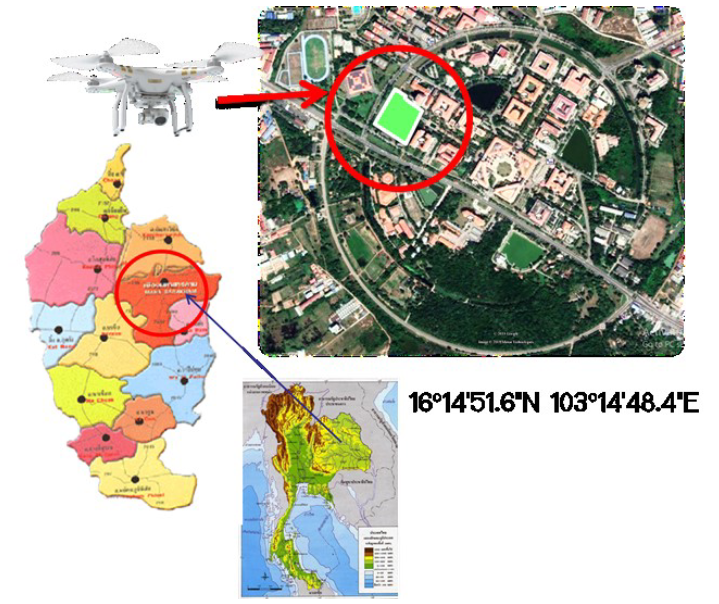Estimation of Algal Bloom Biomass Using UAV-Based Remote Sensing with NDVI and GRVI
doi: 10.14456/mijet.2020.1
Keywords:
Algal Bloom, Biomass, UAV, NDVI, GRVIAbstract
In this paper, the ability to estimate the biomass of algal bloom by using UAV remote sensing with NDVI and GRVI were compared. Mathematical models such as linear, polynomial and power functions were used to determine the correlation between 2 vegetation indices (NDVI and GRVI) and biomass of algal bloom from field survey. Eighty biomass data from field survey was divided half for calibration and half for evaluation data sets. From mathematical models, the power function provided maximum R2 both NDVI and GRVI, NDVI give R2 = 0.72 (RMSE = 38.5) and GRVI give R2 = 0.64 (RMSE = 42.5) for evaluation datasets, respectively. The results showed that NDVI from UAV remote sensing performed better estimation for biomass of algal bloom than GRVI.
References
[2] Thackeray, S. J., Jones, I. D., & Maberly, S. C. (2008). Long‐term change in the phenology of spring phytoplankton: species‐specific responses to nutrient enrichment and climatic change. Journal of Ecology, 96(3), 523-535.
[3] Kim, H. (2010). An overview on the occurrences of harmful algal blooms (HABs) and mitigation strategies in Korean coastal waters. Coastal environmental and ecosystem issues of the east china sea, 121-131.
[4] Van der Merwe, D., & Price, K. (2015). Harmful algal bloom characterization at ultra-high spatial and temporal resolution using small unmanned aircraft systems. Toxins, 7(4), 1065-1078.
[5] Matthews, M. W. (2009). Remote sensing of water quality parameters in Zeekoevlei, a hypertrophic, cyanobacteria-dominated lake, Cape Town, South Africa (Doctoral dissertation, University of Cape Town).
[6] Hallegraeff, G. M. (2003). Harmful algal blooms: a global overview. Manual on harmful marine microalgae, 33, 1-22.
[7] Kirkpatrick, B., Fleming, L. E., Squicciarini, D., Backer, L. C., Clark, R., Abraham, W., ... & Zaias, J. (2004). Literature review of Florida red tide: implications for human health effects. Harmful algae, 3(2), 99-115.
[8] Jung, S., Cho, H., Kim, D., Kim, K., Han, J. I., & Myung, H. (2017). Development of algal bloom removal system using unmanned aerial vehicle and surface vehicle. IEEE Access, 5, 22166-22176.
[9] Zhang, K., Lin, T. F., Zhang, T., Li, C., & Gao, N. (2013). Characterization of typical taste and odor compounds formed by Microcystis aeruginosa. Journal of Environmental Sciences, 25(8), 1539-1548.
[10] Smayda, T. J. (1997). What is a bloom? A commentary. Limnology and Oceanography, 42(5part2), 1132-1136.
[11] Honkavaara, E., Hakala, T., Kirjasniemi, J., Lindfors, A., Mäkynen, J., Nurminen, K., ... & Markelin, L. (2013).
New light-weight stereoscopic spectrometric airborne imaging technology for high-resolution environmental remote sensing case studies in water quality mapping. Int. Arch. Photogram. Remote Sens. Spat. Inf. Sci, 1, W1.
[12] Pölönen, I., Puupponen, H. H., Honkavaara, E., Lindfors, A., Saari, H., Markelin, L., ... & Nurminen, K. (2014, October). UAV-based hyperspectral monitoring of small freshwater area. In Remote Sensing for Agriculture, Ecosystems, and Hydrology XVI (Vol. 9239, p. 923912). International Society for Optics and Photonics.
[13] Nam-Gu, B., CO, L., Jungangdae-ro, D. G., & Gwanganhaebyeon-ro, S. G. (2016). Application of Unmanned Aerial Vehicle Imagery for Algal Bloom Monitoring in River Basin. International Journal of Control and Automation, 9(12), 203-220.
[14] Lyu, P., Malang, Y., Liu, H. H., Lai, J., Liu, J., Jiang, B., ... & Wang, Y. (2017). Autonomous cyanobacterial harmful algal blooms monitoring using multirotor UAS. International journal of remote sensing, 38(8-10), 2818-2843.
[15] Xu, F., Gao, Z., Jiang, X., Shang, W., Ning, J., Song, D., & Ai, J. (2018). A UAV and S2A data-based estimation of the initial biomass of green algae in the South Yellow Sea. Marine pollution bulletin, 128, 408-414.
[16] Bollard-Breen, B., Brooks, J. D., Jones, M. R., Robertson, J., Betschart, S., Kung, O., ... & Pointing, S. B. (2015). Application of an unmanned aerial vehicle in spatial mapping of terrestrial biology and human disturbance in the McMurdo Dry Valleys, East Antarctica. Polar biology, 38(4), 573-578.
[17] Koparan, C., Koc, A., Privette, C., & Sawyer, C. (2018). In situ water quality measurements using an unmanned aerial vehicle (UAV) system. Water, 10(3), 264.
[18] Su, T. C., & Chou, H. T. (2015). Application of multispectral sensors carried on unmanned aerial vehicle (UAV) to trophic state mapping of small reservoirs: a case study of Tain-Pu reservoir in Kinmen, Taiwan. Remote Sensing, 7(8), 10078-10097.
[19] Jang, S. W., Yoon, H. J., Kwak, S. N., Sohn, B. Y., Kim, S. G., & Kim, D. H. (2016). Algal bloom monitoring using UAVs imagery. Adv. Sci. Technol. Lett, 138, 30-33.
[20] Aguirre-Gómez, R., Salmerón-García, O., Gómez-Rodríguez, G., & Peralta-Higuera, A. (2017). Use of unmanned aerial vehicles and remote sensors in urban lakes studies in Mexico. International journal of remote sensing, 38(8-10), 2771-2779.
[21] Goldberg, S. J., Kirby, J. T., & Licht, S. C. (2016). Applications of Aerial Multi-Spectral Imagery for Algal Bloom Monitoring in Rhode Island. SURFO Technical Report No. 16-01, 28.
[22] Shang, S., Lee, Z., Lin, G., Hu, C., Shi, L., Zhang, Y., ... & Yan, J. (2017). Sensing an intense phytoplankton bloom in the western Taiwan Strait from radiometric measurements on a UAV. Remote Sensing of Environment, 198, 85-94.
[23] Van der Merwe, D., & Price, K. (2015). Harmful algal bloom characterization at ultra-high spatial and temporal resolution using small unmanned aircraft systems. Toxins, 7(4), 1065-1078.
[24] Kiage, L. M., & Walker, N. D. (2009). Using NDVI from MODIS to monitor duckweed bloom in Lake Maracaibo, Venezuela. Water resources management, 23(6), 1125-1135.
[25] Son, Y. B., Min, J. E., & Ryu, J. H. (2012). Detecting massive green algae (Ulva prolifera) blooms in the Yellow Sea and East China Sea using geostationary ocean color imager (GOCI) data. Ocean Science Journal, 47(3), 359-375.
[26] Li, Y., Zhang, L. F., Huang, C. P., Wang, J. N., & Cen, Y. (2016). Monitor of cyanobacteria bloom in Lake Taihu from 2001 to 2013 based on MODIS temporal spectral data. Guang pu xue yu guang pu fen xi= Guang pu, 36(5), 1406-1411.
[27] Hu, C. (2009). A novel ocean color index to detect floating algae in the global oceans. Remote Sensing of Environment, 113(10), 2118-2129.
[28] Tucker, C. J. (1979). Red and photographic infrared linear combinations for monitoring vegetation. Remote sensing of Environment, 8(2), 127-150.
[29] Falkowski, M. J., Gessler, P. E., Morgan, P., Hudak, A. T., & Smith, A. M. (2005). Characterizing and mapping forest fire fuels using ASTER imagery and gradient modeling. Forest Ecology and Management, 217(2-3), 129-146.
[30] Suphan, P., Sa-ngiamvibool, W & Kaewplang, S. (2019). Monitoring of Rice Growth with UAV-derived aerial imagery.
[31] Rau, J. Y., Jhan, J. P., Lo, C. F., & Lin, Y. S. (2011). Landslide mapping using imagery acquired by a fixed-wing UAV. Int. Arch. Photogramm. Remote Sens. Spat. Inf. Sci, 38(1/C22), 195-200.
[32] Nagai, S., Saitoh, T. M., Nasahara, K. N., Inoue, T., & Suzuki, R. (2015, December). Accurate detection of spatio-temporal variability of plant phenology by using satellite-observed daily green-red vegetation index (GRVI) in Japan. In AGU Fall Meeting Abstracts.
[33] Ali, I., Greifeneder, F., Stamenkovic, J., Neumann, M., & Notarnicola, C. (2015). Review of machine learning approaches for biomass and soil moisture retrievals from remote sensing data. Remote Sensing, 7(12), 16398-16421.
[34] Han, L., Yang, G., Dai, H., Xu, B., Yang, H., Feng, H., ... & Yang, X. (2019). Modeling maize above-ground biomass based on machine learning approaches using UAV remote-sensing data. Plant methods, 15(1), 10.
[35] Yang, S., Feng, Q., Liang, T., Liu, B., Zhang, W., & Xie, H. (2018). Modeling grassland above-ground biomass based on artificial neural network and remote sensing in the Three-River Headwaters Region. Remote Sensing of Environment, 204, 448-455.

Downloads
Published
How to Cite
Issue
Section
License
Copyright (c) 2020 Mahasarakham International Journal of Engineering Technology

This work is licensed under a Creative Commons Attribution-NonCommercial-NoDerivatives 4.0 International License.




